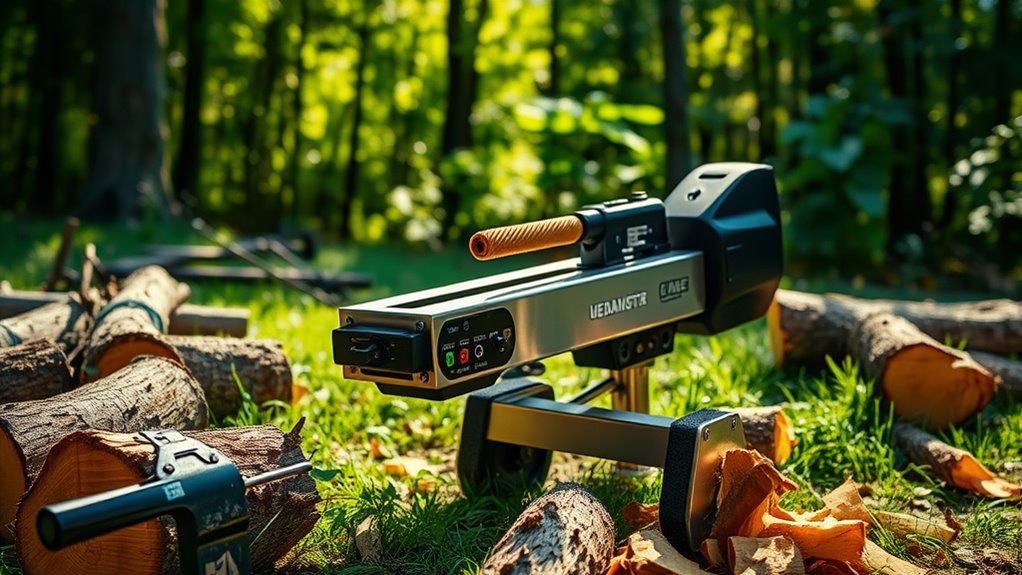A life cycle analysis of electric log splitters shows they have a lower environmental impact compared to gas-powered models, thanks to responsible sourcing of materials, efficient manufacturing, and emissions-free operation. You benefit from their durability, low maintenance needs, and recyclability at end-of-life. Proper use and disposal can maximize eco-friendliness and energy savings. To understand how every stage affects sustainability and what improvements are possible, keep exploring these vital aspects.
Key Takeaways
- Evaluates environmental impacts from raw material extraction and manufacturing to end-of-life disposal and recycling.
- Assesses energy consumption during operation, including motor and battery efficiency, and potential renewable energy use.
- Considers durability, maintenance requirements, and repair frequency affecting lifespan and overall sustainability.
- Analyzes the reduction of emissions and pollutants compared to gas-powered log splitters throughout their life cycle.
- Identifies opportunities for eco-friendly design, recyclability, and responsible end-of-life management to enhance environmental benefits.
Raw Material Extraction and Processing

Raw material extraction and processing form the foundation of an electric log splitter’s life cycle. Your journey begins with material sourcing, where raw resources like steel, aluminum, and plastics are obtained from mines and suppliers. The supply chain plays a vital role here, as it guarantees these materials are responsibly and sustainably sourced. During extraction, energy consumption and environmental impact are significant factors to contemplate. Once extracted, raw materials undergo processing—smelting, refining, and shaping—to prepare them for manufacturing. This stage sets the stage for product durability and performance. By understanding the supply chain’s efficiency and the environmental footprint of material sourcing, you can better appreciate how early decisions influence the overall sustainability of your electric log splitter. Responsible sourcing ensures materials are obtained with minimal environmental harm. Additionally, advancements in material processing techniques can help reduce energy use and waste during this phase. Implementing sustainable practices in these early stages further enhances the eco-friendliness of the final product. Moreover, ongoing innovations in material recycling contribute to a circular economy, reducing the need for virgin resources and lowering environmental impacts, which is essential for promoting eco-friendly manufacturing.
Manufacturing and Assembly Stages
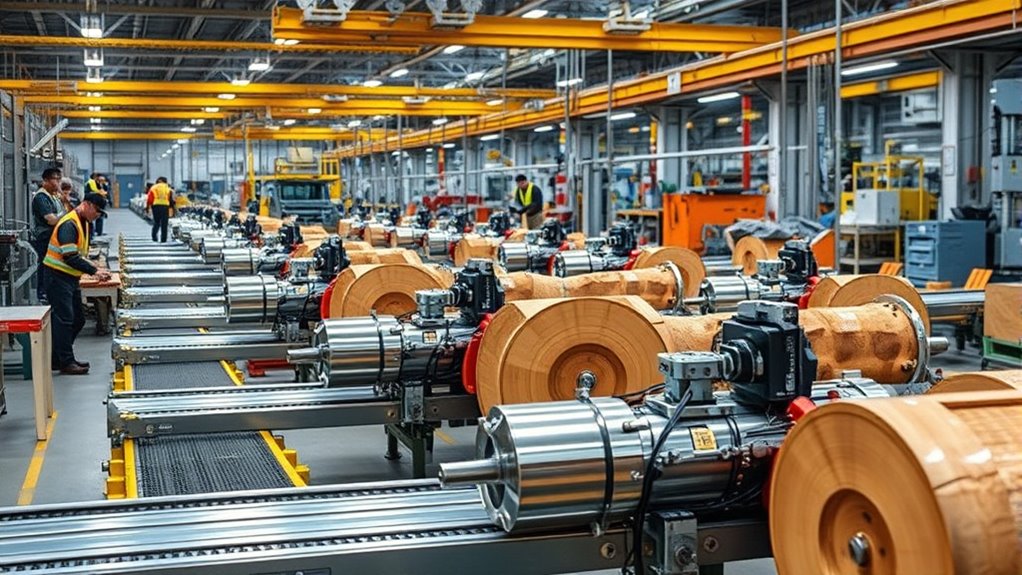
The manufacturing and assembly stages transform raw materials into the functional components of an electric log splitter. During these stages, manufacturers focus on optimizing power efficiency by selecting energy-saving motors and durable materials. They also emphasize ergonomic design to guarantee user comfort and safety, integrating features like easy-to-handle controls and adjustable components. Precision assembly assures that each part aligns correctly, reducing waste and improving overall performance. Quality checks at this stage help identify defects early, supporting the device’s longevity. Incorporating sustainable manufacturing practices into branding and marketing strategies can enhance customer engagement and brand loyalty. Additionally, integrating eco-friendly materials can further reduce environmental impact during production. Your electric log splitter’s durability and ease of use depend heavily on these meticulous manufacturing and assembly processes.
Energy Consumption During Operation
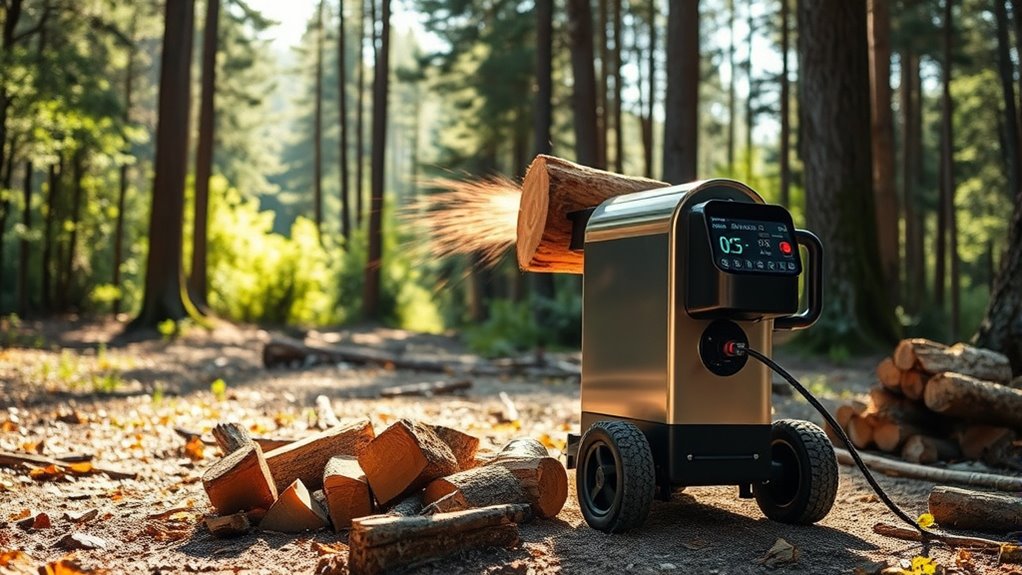
During operation, electric log splitters consume energy primarily through their motors, which power the splitting mechanism. The amount of energy used depends on the motor’s efficiency and the workload. Battery efficiency plays a vital role; higher efficiency means you get more splitting power per charge, reducing overall energy consumption. When considering battery-powered models, the charging impact is significant—frequent or rapid charging can increase energy use and affect battery lifespan. Operating at ideal power levels minimizes unnecessary energy drain. Additionally, using the splitter efficiently, such as avoiding prolonged idle states, helps conserve energy. Moreover, awareness of AI vulnerabilities in safety systems can inform better operational practices to prevent accidents and ensure efficient energy use. Proper maintenance, including checking for wear and tear on components, can also help optimize energy efficiency. Understanding how your splitter’s motor and battery efficiency interact, along with energy conservation techniques, will help you manage energy consumption and reduce the environmental impact during operation.
Maintenance and Repair Impacts
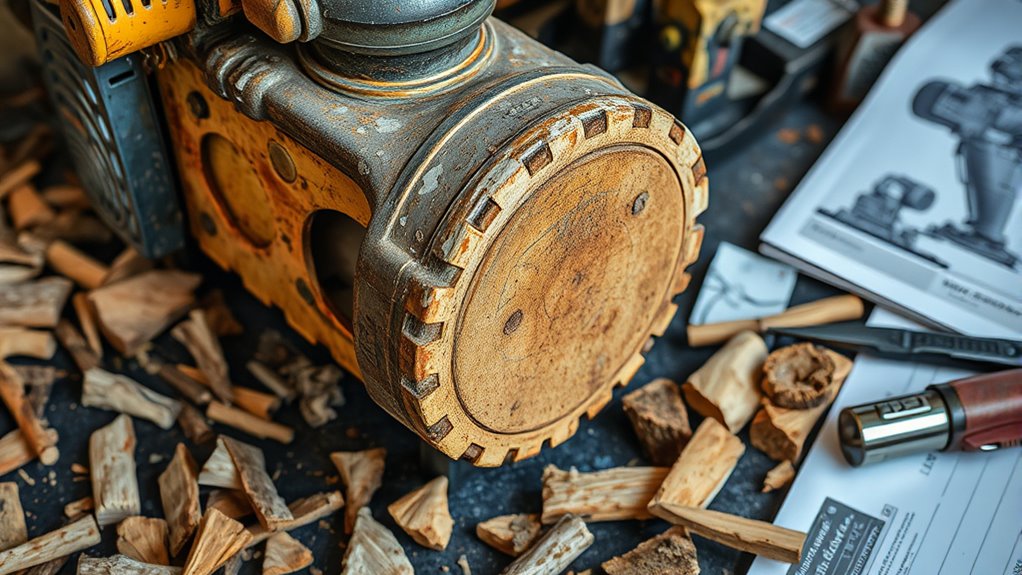
Maintenance and repairs can considerably impact your electric log splitter’s overall efficiency and costs. Frequent repairs and high expenses may lead to more downtime and lost productivity. However, investing in durable models can reduce long-term repair needs and improve your splitter’s lifespan. Additionally, selecting brands with a reputation for trustworthiness and quality can further minimize repair frequency and ensure reliable performance. Proper maintenance routines, such as regular inspections and timely part replacements, can also help prevent unexpected failures. Being aware of wear and tear can guide you in scheduling preventative care to extend the device’s operational life. Incorporating preventative maintenance practices can significantly decrease the likelihood of costly repairs and extend equipment longevity. Cultivating a growth mindset by viewing maintenance as an opportunity for learning and improvement can contribute to better care of your equipment. Recognizing the importance of state-specific benefits can also inform you of available resources to support your maintenance efforts.
Repair Frequency and Costs
Repair frequency and costs play an essential role in evaluating the overall sustainability of electric log splitters. Higher repair frequency increases maintenance costs and can impact your investment’s longevity. When repair needs are infrequent, you save on parts and labor, making the splitter more cost-effective over its life cycle. Regular maintenance reduces unexpected repairs, lowering repair frequency and associated costs. Here’s a breakdown:
| Repair Frequency | Maintenance Costs | Impact on Sustainability |
|---|---|---|
| Low | Low | Higher durability |
| Moderate | Moderate | Balanced performance |
| High | High | Increased expenses |
| Very high | Very high | Reduced lifespan |
| None | Minimal | optimal efficiency |
Monitoring repair frequency helps optimize your electric log splitter’s performance and costs. Additionally, selecting models with proven industry reliability can further reduce repair needs over time, enhancing overall product longevity. Ensuring proper safety standards and quality materials in the chosen equipment can also contribute to reducing repair frequency and maintaining consistent performance. Maintaining proper lubrication and timely part replacements can extend the operational life of the equipment and prevent more costly repairs.
Downtime and Productivity Loss
When your electric log splitter experiences downtime due to maintenance or repairs, it directly interrupts your workflow and reduces productivity. During these periods, machine efficiency drops as you wait for repairs to finish, delaying your project timeline. Frequent downtime can lead to frustration and decreased overall output, especially if you rely heavily on the splitter. Additionally, maintenance and repair activities impact user safety by increasing the risk of accidents if not handled properly. Ensuring timely service minimizes unexpected breakdowns and keeps your equipment running smoothly, preserving productivity. Proper maintenance routines help maintain ideal machine efficiency and protect you from potential hazards, allowing you to complete tasks safely and efficiently without prolonged interruptions.
Long-term Durability Benefits
Frequent downtime from maintenance and repairs can substantially shorten the lifespan of your electric log splitter. To maximize durability, you should focus on durability testing and selecting materials with high material longevity. These factors contribute to long-term benefits by reducing the need for repairs and extending operational life. Proper maintenance ensures your splitter withstands tough logs and environmental conditions.
| Aspect | Impact | Benefit |
|---|---|---|
| Durability Testing | Identifies weak points early | Enhances overall lifespan |
| Material Longevity | Resists wear and corrosion | Reduces repair frequency |
| Maintenance | Prevents costly breakdowns | Sustains performance over years |
| Repair Impacts | Minimizes downtime | Keeps productivity high |
End-of-Life Disposal and Recycling
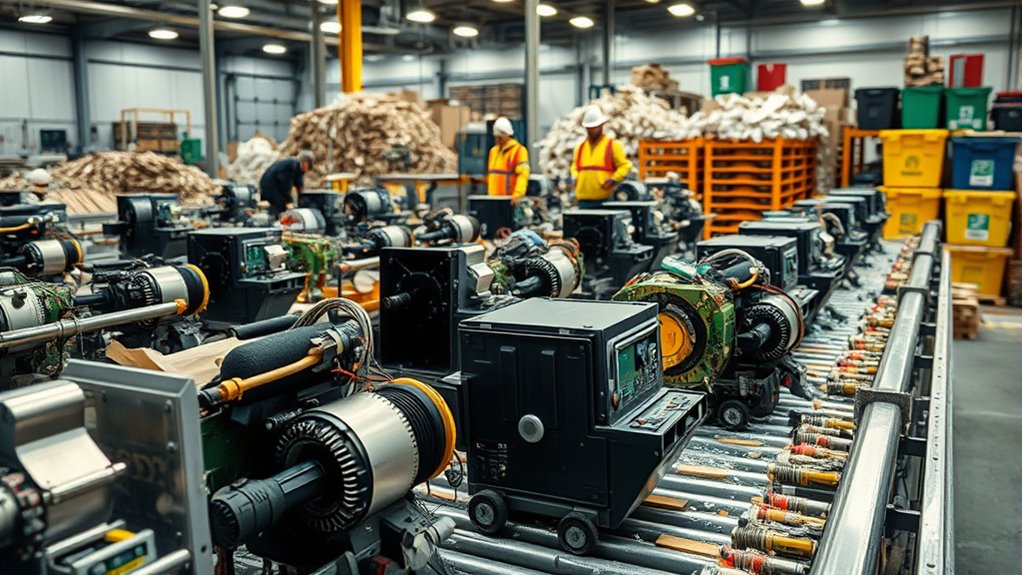
As electric log splitters reach the end of their service life, proper disposal and recycling become essential to minimize environmental impact. You should look for authorized recycling programs that handle electronic and metal components responsibly. Many regions have specific disposal regulations requiring you to separate hazardous materials and guarantee safe disposal of batteries, motors, and wiring. By participating in these programs, you help reduce waste and prevent harmful substances from contaminating the environment. Always check local guidelines to verify compliance. Recycling also allows valuable materials like steel and copper to be recovered and reused, closing the loop in the product’s life cycle. Proper disposal and recycling are vital steps to make certain your electric log splitter’s end-of-life process remains environmentally friendly.
Environmental Benefits Compared to Gas-Powered Models
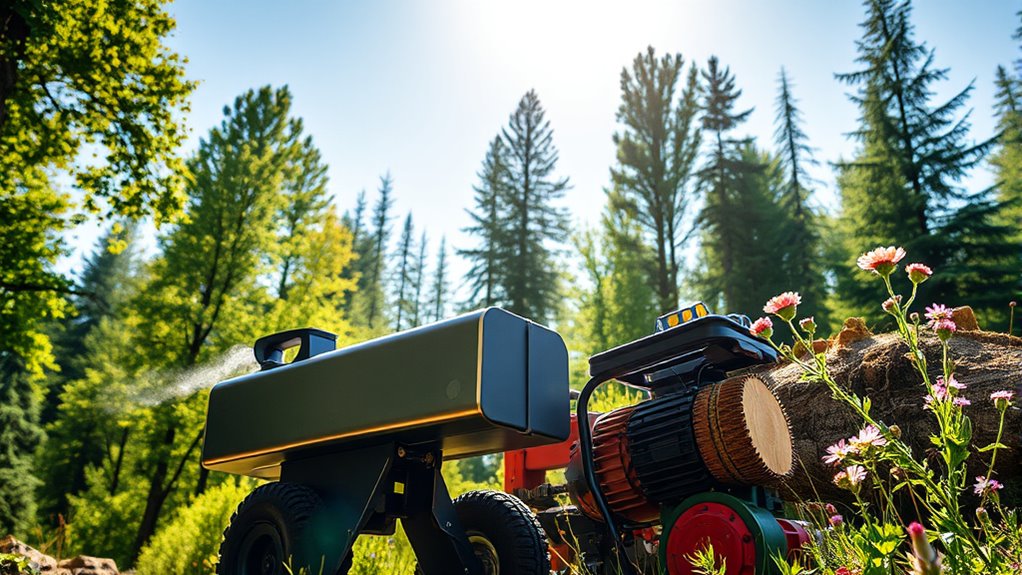
Electric log splitters offer significant environmental advantages over traditional gas-powered models because they produce no direct emissions. This means you reduce your carbon footprint by avoiding the pollutants released during combustion. When powered with renewable energy, their environmental impact diminishes further, making them a cleaner choice overall. Unlike gas models that emit greenhouse gases and smog-forming pollutants, electric splitters operate quietly and with less air pollution. They also eliminate the risk of fuel spills and leaks, which can harm soil and water sources. By choosing electric over gas, you support cleaner air and contribute to reducing greenhouse gas emissions, especially if your electricity comes from renewable sources. Overall, electric log splitters help you minimize your environmental impact while maintaining effective performance.
Opportunities for Sustainable Improvement
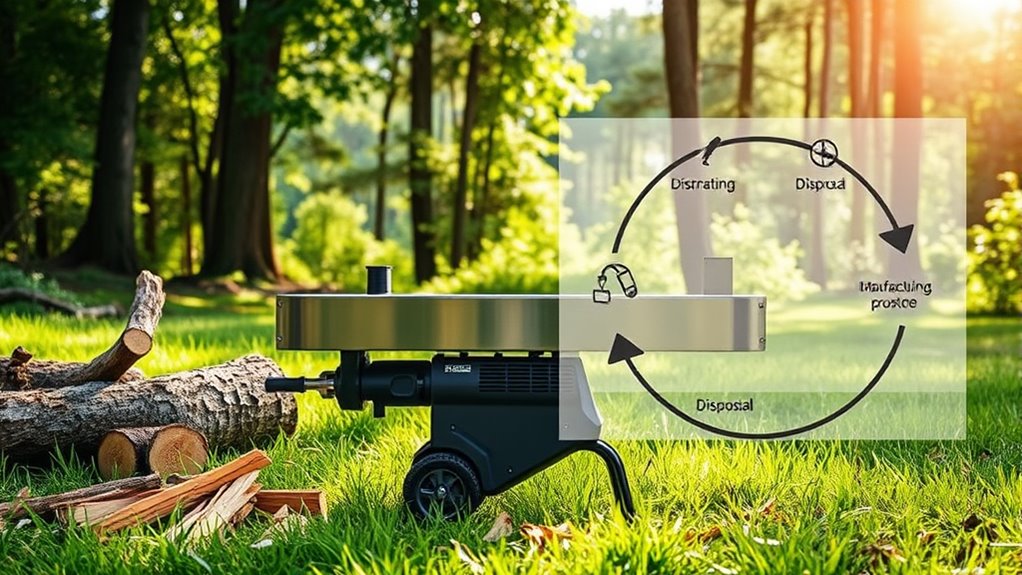
While electric log splitters already offer notable environmental benefits, there’s still room to enhance their sustainability. You can support this by prioritizing models powered by renewable energy sources. Switching to green electricity reduces carbon footprints further and encourages cleaner energy adoption. Additionally, look for eco labeling on products—these certifications guarantee sustainable manufacturing and lower environmental impact.
| Opportunity | Impact |
|---|---|
| Using renewable energy | Reduces greenhouse gases and reliance on fossil fuels |
| Eco labeling adoption | Promotes environmentally responsible choices |
| Design for recyclability | Minimizes waste and supports circular economy |
Consumer Choices and Responsible Usage
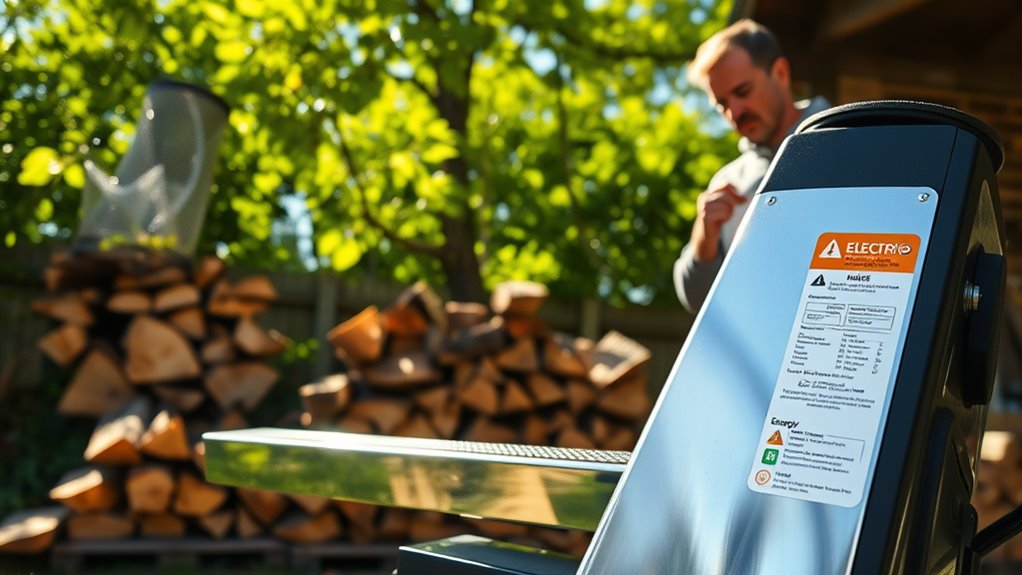
Your choices matter when it comes to electric log splitters; selecting models with sustainable features can reduce environmental impact. Using your splitter safely and following proper operating practices extends its lifespan and minimizes waste. By making informed decisions and practicing responsible use, you help support a more sustainable energy cycle.
Sustainable Purchase Decisions
When choosing an electric log splitter, considering its environmental impact can help you make a more sustainable purchase. Start by researching material sourcing—opt for models made with recycled or responsibly sourced materials to reduce ecological harm. Educate yourself on the manufacturer’s sustainability practices, such as energy-efficient production methods and eco-friendly packaging. Your consumer choices directly influence the market, encouraging companies to prioritize environmentally responsible practices. Additionally, compare different models for durability and energy efficiency, ensuring your purchase minimizes long-term environmental costs. Responsible buying isn’t just about the product itself but also about understanding how it’s made and how your usage impacts the environment. Making informed decisions supports sustainable manufacturing and promotes a greener, more responsible approach to outdoor equipment.
Safe Operating Practices
Practicing safe operating habits is essential to maximize the lifespan of your electric log splitter and reduce environmental risks. Prioritize operator safety by always wearing protective gear, such as gloves and eye protection, to prevent injuries. Follow manufacturer instructions carefully, ensuring proper setup and use. Regularly inspect the equipment for damage or wear, addressing issues promptly to avoid hazards. Keep the work area clear of debris and bystanders to minimize accident risks. Safe operation also involves avoiding overloading the splitter and using it only for its intended purpose. By adopting these hazard prevention measures, you not only protect yourself but also extend the device’s longevity. Responsible usage is key to minimizing environmental impact and ensuring safe, efficient log splitting.
Frequently Asked Questions
What Are the Long-Term Environmental Impacts of Electric Log Splitters?
You might wonder about the long-term environmental impacts of electric log splitters. By choosing electric models powered by renewable energy, you reduce reliance on fossil fuels, lowering emissions. Additionally, focusing on material recycling helps minimize waste and resource depletion. Over time, these practices can lead to a smaller carbon footprint, promote sustainability, and protect ecosystems, making electric log splitters a more eco-friendly option for your wood-splitting needs.
How Does Supply Chain Sustainability Affect the Overall Lifecycle?
You should consider how supply chain sustainability impacts the overall lifecycle of electric log splitters. When material sourcing is responsible and eco-friendly, it reduces environmental harm and promotes ethical practices. A sustainable supply chain guarantees that materials are responsibly extracted and processed, lowering carbon footprints and waste. This positive influence extends throughout the product’s lifecycle, making it more environmentally friendly from production to disposal, aligning with long-term ecological goals.
Are There Eco-Friendly Alternatives to Traditional Battery Technologies Used?
Imagine swapping out a plastic bottle for a biodegradable one—you’re making a positive impact. Similarly, eco-friendly alternatives like renewable power sources and biodegradable batteries are changing how we power devices. These options reduce environmental harm and promote sustainability, making your choices greener. By choosing renewable power and biodegradable batteries, you’re supporting innovations that lessen e-waste and reliance on fossil fuels, helping create a healthier planet for future generations.
What Certifications Indicate a Product’S Environmental Responsibility?
You should look for eco labels and green certifications on products, as they indicate environmental responsibility. Certifications like ENERGY STAR, USDA Organic, or Forest Stewardship Council (FSC) suggest the product meets specific eco-friendly standards. These labels help you make informed choices, ensuring you’re supporting sustainable practices. Always check for recognized eco labels, which serve as reliable indicators of a product’s commitment to reducing environmental impact.
How Does the Lifespan of Electric Log Splitters Compare to Gas Models?
Did you know electric log splitters often last up to 15 years, compared to around 10 years for gas models? You’ll find that their battery longevity and lower maintenance frequency contribute to this longer lifespan. Electric models tend to be more durable since they have fewer moving parts and don’t require oil changes. So, choosing an electric splitter can save you money and hassle over time, making it a smarter, more eco-friendly investment.
Conclusion
As you consider electric log splitters, picture a clear stream flowing smoothly, untouched by pollution. Embracing this eco-friendly choice, you become part of a cycle that nurtures the earth, reducing emissions and waste. Your responsible usage and mindful disposal help sustain this pristine flow. Together, your actions ripple outward, fostering a healthier environment for future generations—turning your everyday decisions into powerful currents of positive change.
